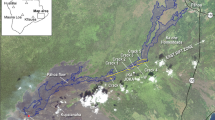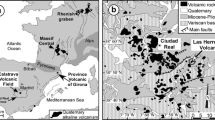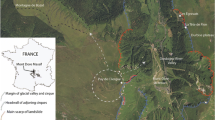Abstract
Tumuli are positive topographic features that are common on Hawaiian pahoehoe lava flow fields, particularly on shallow slopes, and 75 measured examples are presented here to document the size range. Tumuli form by up-tilting of crustal plates, without any crustal shortening, and are thus distinguished from pressure ridges which are up-buckled by laterally directed pressure. The axial or star-like systems of deep clefts that characterize tumuli are defined here as “lava-inflation clefts”; their tips advanced into red-hot lava and they widened as uplift proceeded and while the lava crust was thickening. Flat-surfaced uplifts, formed like tumuli by injection of lava under a surface crust, were previously called pressure plateaus, but “lava rise” is proposed instead. The pits that abound among lava rises, previously attributed to collapse or subsidence, are generally formed because the lava around them rose, and the name “lava-rise pit” is proposed. Unique examples of tumuli and lava rises, from which lava drained out under a surface crust 1.5 to 2.5 m thick, are described from Kilauea caldera. These examples show that in tumuli and lava rises the crust floats on considerable bodies of fluid lava, and is able to do so because of its higher vesicle content: the fluid lava loses many of its gas bubbles during residence beneath the crust. The bulk densities of samples from tumuli show a general downward increase. The form of the density profile is consistent with the relationship that for any given crustal thickness the density of fluid lava closely matched the average density of that crust, suggesting that the lava was stably density-stratified. It is inferred that stable stratification was regulated by out-flows of the more vesicular lava fractions, loss of bubbles through the lava-inflation clefts, and entry of injected lava at its level of neutral buoyancy. Below the uppermost meter the downward decrease in vesicularity closely conforms with that expected by compression of a uniform mass of gas per unit mass of lava.
Similar content being viewed by others
References
Anderson SW, Fink JH (1988) Crease structures as lava emplacement rate indicators (abstr). EOS 69:1486
Anderson T (1910) The volcano of Matavanu in Savaii. Geol Soc Lond Quart J 66:621–639
Aubele JC, Crumpler LS, Elston W (1988) Vesicle zonation and vertical structure of basalt flows. J Volcanol Geotherm Res 35:349–374
Bartrum JA (1928) Lava slickensides at Auckland. NZ J Sci Technol 10:23–25
Bullard FM (1976) Volcanoes of the Earth. University of Texas Press, Austin, 579 pp
Champion DE, Greeley R (1977) Geology of the Wapi lava field, Snake River Plain, Idaho. In: Greely R, King JS (eds) Volcanism of the eastern Snake River Plain, Idaho. NASA: 133–152
Cotton CA (1952) Volcanoes as landscape forms. Hafner Pub Co, New York, 416 pp
Daly RS (1914) Igneous rocks and their origin. McGraw Hill, New York
Dana JD (1887) Characteristics of volcanoes. Dodd, Mead and Co, New York, 399 pp
Francis PW, Roobol MJ, Walker GPL, Cobbold PR, Coward M (1974) The San Pedro and San Pablo volcanoes of northern Chile and their hot avalanche deposits. Geol Rdsch 63:357–388
Friedländer I (1914) Über die Kleinformen der vulkanischen Produkte. III Laven. Zeit Vulkan 1:219–224
Gary M, McAfee R, Wolf CL (eds) (1972) Glossary of Geology. Am Geol Inst
Green J, Short NM (1971) Volcanic landforms and surface features. Springer, Berlin Heidelberg New York, pp 519
Guba I, Mustafa H (1988) Structural control of young basaltic fissure eruptions in the plateau basalt area of the Arabian plate, northeastern Jordan. J Volcan Geotherm Res 35:319–334
Guest JE, Wood C, Greeley R (1984) Lava tubes, terraces and megatumuli on the 1614–24 pahoehoe lava flow field, Mount Etna, Sicily. Bull Volcan 49:635–648
Hardee HC (1980) Solidification in Kilauea Iki lava lake. J Volcan Geotherm Res 7:211–223
Jaggar TA (1931) Lava stalactites, stalagmites, toes and “squeeze-ups”. The Volcano Letter, Hawaiian Volcano Obs, no 345:1–2
James AVG (1920) Factors producing columnar jointing in lavas. J Geol 28:458–469
Macdonald GA (1967) Forms and structures of extrusive basaltic rocks. In: Hess HH, Poldervaart A (eds) Basalts. The Poldervaart treatise on rocks of basaltic composition. Interscience Publ, New York Vol 1: 1–61
Macdonald GA (1972) Volcanoes Prentice-Hall, Englewood Cliffs, NJ. 510 pp
Murase T, McBirney AR (1973) Properties of some common igneous rocks and their melts at high temperatures. Geol Soc Am Bull 84:3563–3592
Nichols RL (1939) Surficial banding and shark's-tooth projections in the cracks of basaltic lava. Am J Sci 237:188–194
Nichols RL (1946) McCartys basalt flow, Valencia Country, New Mexico. Geol Soc Am Bull 57:1049–1086
Ollier C (1969) Volcanoes. Austral Natl Univ Press, Canberra, 177 pp
Ollier C (1988) Volcanoes. Blackwell, Oxford, 228 pp
Peck DL (1978) Cooling and vesiculation of Alae lava lake, Hawaii. US Geol Surv Prof Pap 935-B, 59 pp
Peck DL, Wright TL, Moore JG (1966) Crystallization of tholeiitic basalt in Alae lava lake, Hawaii. Bull Volcan 29:629–655
Perret FA (1950) Volcanological observations. Carnegie Instn, Washington Pub 549, 162 p
Rowland SK, Walker GPL (1987) Toothpaste lava: characteristics and origin of a lava structural type transitional between pahoehoe and aa. Bull Volcan 49:577–587
Russell IC (1902) Geology and water resources of the Snake River Plains of Idaho. US Geol Surv Bull 199: 192 pp
Ryan MP, Sammis CG (1978) Cyclic fracture mechanisms in cooling basalt. Geol Soc Am Bull 89:1295–1308
Sapper K (1919) Über hornitos und verwandt gebilde. Zeit Vulcan 5:1–39
Skeats EW, James AVG (1937) Basaltic barriers of western Victoria. Proc R Soc Victoria 49 (n s): 245–278
Swanson DA (1973) Pahoehoe flows from the 1969–1971 Mauna Ulu eruption, Kilauea volcano, Hawaii. Geol Soc Am Bull 84:615–626
Swanson DA, Dzurisin D, Holcomb RT, Iwatsubo EY, Chadwick WW, Casadevall TJ, Ewart JW, Heliker CC (1987) Growth of the lava dome at Mount St Helens, Washington, (USA), 1981–1983. Geol Soc Am Spec Pap 212:1–16
Tyrrell GW (1931) Volcanoes. Henry Holt and Co, New York, 252 pp
Waesche HH (1940) Mauna Loa summit crater eruption, 1940. The Volcano Letter, no 468: 1–9
Walker GPL (1969) The breaking of magma. Geol Mag 106:166–173
Walker GPL (1989) Spongy pahoehoe in Hawaii: a study of vesicle-distribution patterns in basalt and their significance. Bull Volcanol 51:199–209
Watanabe K, Katsui Y (1976) Pseudo-pillow lavas in the Aso caldera, Kyushu, Japan. J Jap Assoc Mineral Petrol Econ Geol 71:44–49
Wentworth CK, Macdonald GA (1953) Structures and forms of basaltic rocks in Hawaii. US Geol Surv Bull 994, 98 pp
Williams H, McBirney AR (1979) Volcanology. Freeman Cooper and Co, San Francisco, 397 pp
Wright TL, Okamura RT (1977) Cooling and crystallization of tholeiitic basalt, 1965 Makaopuhi lava lake, Hawaii. US Geol Surv Prof Pap 1004. 78 p
Author information
Authors and Affiliations
Rights and permissions
About this article
Cite this article
Walker, G.P.L. Structure, and origin by injection of lava under surface crust, of tumuli, “lava rises”, “lava-rise pits”, and “lava-inflation clefts” in Hawaii. Bull Volcanol 53, 546–558 (1991). https://doi.org/10.1007/BF00298155
Received:
Accepted:
Issue Date:
DOI: https://doi.org/10.1007/BF00298155




